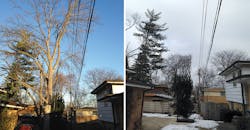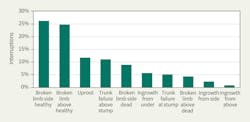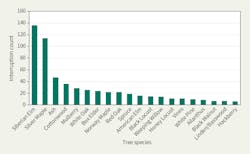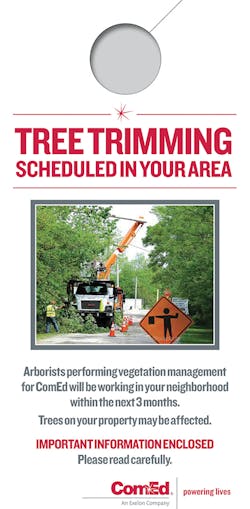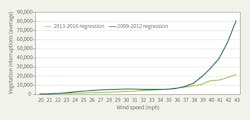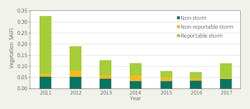Targeted Tree Trimming Offers Reliability Benefits
After several years of heavy storms and numerous tree-related outages, utility vegetation managers have begun to scrutinize and ask themselves what additional steps they can take to improve reliability, aside from the standard cyclical trimming programs. To answer this important question, Commonwealth Edison (ComEd) sought a new way to look at tree-related outage data. Its goal was to find ways to target tree-trimming efforts better, beyond the normal cycle clearances, to harden the system for future storms.
A unit of Exelon Corp, ComEd provides service to more than 3.9 million customers in 400 municipalities over a service territory of 11,400 sq miles in northern Illinois and maintains 35,000 miles of overhead distribution lines as well as more than 5,000 miles of transmission lines. On Oct. 27, 2011, the Illinois General Assembly enacted the Energy Infrastructure Modernization Act. This led to a $2.6 billion investment by ComEd to strengthen and modernize the electric grid in the one-third part of northern Illinois it services.
The major components of this plan were reliability-related investments and smart grid investments. Under the reliability plan, two main goals were put forth: to reduce the frequency of customer interruptions by 20% and to reduce the duration of interruptions by 15% over the course of a 10-year period. ComEd put into place several initiatives to accomplish these goals, one of which was the storm-hardening program. This program aimed to achieve the reliability targets through engineering solutions such as overhead-to-underground cable conversions, installation of tree-resistant spacer cable, enhanced tree trimming and a combination of these.
Storm-Hardening Areas
The vegetation component of the storm-hardening program looked to pinpoint the locations of tree-related problem areas on the system, identify the main causes and, over the course of several years, identify the best ways to correct them. ComEd looked at data to determine which devices had the highest tree-related outage counts, which types of trees caused the most outages and how those outages occurred. Armed with this data, the utility set out to strategically trim and remove trees in identified problem areas to reduce or eliminate tree-related outages.
With funding in place, the next step was identifying which areas should be storm-hardened. ComEd’s reliability engineers developed a metric, called the customer target program, for the worst-performing customers. Customers made the list in two ways: outage frequency, where the customer experienced seven or more outages each year for the last three years; and outage duration, where the customer experienced 18 or more hours of outage duration for the last three years.
Engineers also focused on customers who are candidates to make the list the next year and went after them proactively.
The goal set for the program was an annual reduction in the number of customers who meet the target criteria until the utility identifies a total of not more than 97 in the target class by 2022.
Once the target customers had been determined, the next step was to determine the best approach for improving their reliability. To help ensure ComEd would be performing the right work to reduce outages, regional engineering evaluated each circuit feeding the customers to determine the problem and propose a mitigation solution. Problem areas typically were associated with individual single-phase taps.
Each tap, or job, went through a challenge session whereby the proposed solutions were selected based on budget and feasibility, with the reliability benefit held paramount. The vegetation management department was charged with inspecting and evaluating the heavily treed areas. These challenge sessions determined whether the tap in question would be converted to underground, converted to spacer cable or if enhanced trimming could mitigate the issue.
Vegetation Work Scope
When vegetation management was determined as the solution for target customers, ComEd needed a strategy for the tree work to be performed. The goal was to identify and eliminate vegetation that would be a threat to utility lines and equipment in a major storm event. To determine which trees to target, ComEd uses a team of contract arborists to investigate tree-coded outages that meet certain criteria. Arborists record outage location, tree species, failure type, aspect, conditions and other items.
A database compiled using these outage investigations helps to identify which trees cause the most outages and which parts of the trees cause the outages. The top five outage-causing trees accounted for roughly 60% of outages; healthy broken limbs from the side and from above were responsible for 56% of the outages. As a result, it was decided that targeting full removal of the highest outage-causing species (large silver maple and Siberian elm), removing trapped and risk trees before they become a problem, and pruning threatening overhang situations was the appropriate package solution.
Developing the Work Plan
The identified course of action went well beyond anything that would have occurred through regular cyclical trimming. ComEd planned to accomplish the expanded effort by developing a tree-risk assessment methodology, producing solid plans with homeowner buy-in and using a dedicated workforce trained in advanced removal techniques to perform the work safely and effectively. ComEd followed this process:
• Identify the work scope. A contract team of foresters walked the entire length of the tap and recorded trees that met the criteria for trimming and removal using individual tree-risk assessments. Trees were flagged for removal or trimming for the tree crews.
• Develop a location-by-location plan. At each address, a GPS point was taken with work planning software to give a detailed description of the work. The data from these points was entered in a full plan for the tree crew to execute.
• Begin notifications (municipal and private). Each tree owner was notified according to Illinois law at least 21 days before the beginning of tree work. Every effort was made to have a personal discussion with the homeowner for plans greater than the normal work scope. Literature was given to the homeowner to explain the nature of the work and why there was a need to trim or remove a tree.
• Schedule work. Tree work was scheduled based on priority, budget and crew locations, and then put into monthly plans and given to the contract workers to execute.
• Perform quality assurance. A 100% quality audit was performed on the storm-hardening jobs and any deficiencies noted were reworked.
Work Implementation
Crews that could be spared from ComEd’s normal cycle-trimming activities were used when the program’s storm-hardening work began. This proved problematic because it was never known how many crews would be made available until the month the work was to be performed. ComEd also did not know the specific advanced training level of this changing workforce.
When a crew is accustomed to clipping branches and making small cuts to achieve 6 ft to 12 ft of clearance, removing 18-inch-diameter cottonwood branches or taking down 60-ft to 100-ft trees is a whole different matter. As the program progressed, a few safety incidents and outages occurred whereby the need to have a trained and dedicated workforce became apparent. This led to the creation of a storm-hardening team, which consists of roughly 40 crews split between manual/climbing and lift/bucket.
Along with having a dedicated crew, the storm-hardening team needed to be trained to perform safely and effectively the type of work it would likely encounter. Therefore, each crew was trained on advanced rigging and roping techniques, and they were given specialized equipment such as blocks, pulleys and port-a-wraps needed to remove large limbs and trees safely. Crews also were trained for crane removals and in the use of backyard buckets. This led to a significant increase in crew productivity and safety
Is the Program Working?
ComEd has storm-hardened more than 844 miles since 2012, and the results show significant progress — not only in the customer target numbers going down but also in the vegetation system average interruption frequency index (SAIFI) going down every year except for 2017. Overall, there has been a significant reduction in the official target customers from 2012 to 2017.
The data for high wind events clearly shows a reduction in vegetation outages during these events. The average interruptions for high wind speeds were much lower from 2013 to 2016 than they were over the same amount of time before the storm-hardening program began prior to 2012.
Even with a reduction in the number of customer outages during these events, 2017 saw an overall increase in vegetation SAIFI. The number of days with more than 2 inches of rain combined with 30-mph to 40-mph average wind speeds as well as days with wind gusts of more than 40 mph increased from the historical average. An unusually wet spring with record-breaking flooding also caused more uprooting of trees than typical.
One growing concern in the ComEd system is the number of dead and dying ash trees. The percentage of outages caused by ash trees increased tremendously in 2017 and now account for the second-highest number of outages on the system. ComEd is addressing the ash issue proactively with a separate program; however, the sheer volume of ash in the service territory means the utility will probably see more ash outages until the population is gone or has been removed.
The focus going forward will be to continue targeting outage-causing species, including ash trees, and using tree-coded outage data to make program changes and adapt to trends found in the data.
Program Postscript
The five-year Illinois Energy Infrastructure Modernization Act program ended in June 2017. The program was successful, and the results of the vegetation component have shown significant value in reducing customer outages where the targeted tree work was performed. The success of the program reflects contributions by the vegetation department on the vegetation-related storm-hardening component as well as contributions by other departments on engineering reliability solutions.
For example, the vegetation department worked in tandem with ComEd’s reliability engineers and regional engineering functions to identify root causes, and the engineering functions also worked on hardware and other reliability solutions, including distribution automation, which added devices and systems to operate portions of the distribution grid remotely.
Because of the success of the vegetation component of the program, ComEd has made a financial commitment to continue the vegetation storm-hardening program, now called the enhanced trimming program. This commitment, combined with identifying the correct circuits and trees to target, will enable the utility to continue reducing customer outages, thereby improving reliability and hardening the ComEd system for the future. ♦
Shaun Wismer joined ComEd in 2012 to develop and manage its storm-hardening program. As a senior program manager, he manages the enhanced trimming program. Previously, he was a field supervisor with the Davey Resource Group and worked on various T&D projects. He holds a BS degree in forestry from Southern Illinois University with an emphasis on resource management and has an International Society of Arboriculture utility arborist certification as well was a tree-risk assessment qualification.
About the Author
Shaun Wismer
Shaun Wismer joined ComEd in 2012 to develop and manage its storm-hardening program. As a senior program manager, he manages the enhanced trimming program. Previously, he was a field supervisor with the Davey Resource Group and worked on various T&D projects. He holds a BS degree in forestry from Southern Illinois University with an emphasis on resource management and has an International Society of Arboriculture utility arborist certification as well was a tree-risk assessment qualification.
